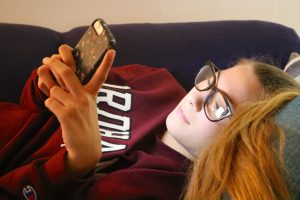By Angelina Caruso

My first week back at school for the semester, I just felt off. Something didn’t sit right. My brain couldn’t focus, I felt sluggish. No matter what I did, I couldn’t get enough sleep. I was dismissive of these symptoms, attributing them to my body adjusting to a set schedule after a summer without one. Quickly, the first week back turned into the first month back, and I still couldn’t shake the discomfort. What was wrong?
The last time I had felt sharp-minded and capable was over the summer. What had changed between then and now? I ran through a mental list, skipping over the big changes and instead looking for minute details that weren’t obvious.
Finally, it hit me.
Over the summer, I had read “Headstrong” by Dave Asprey, an insightful read that details the process of biohacking. According to Asprey, “Biohacking is the art and science of changing the environment around you and inside you, so you have more control over your own biology.” Basically, he argues that humans have the potential to utilize a lot of energy, but we engage in behaviors and activities that limit our ability to do so. Intrigued, I spent my summer working on my own biohacking. I strongly feel that my experience with biohacking enhanced my quality of life. Those skeptical of the concept have a right to be; why would humans naturally act against what is best for us? We have a multitude of instincts that work to our advantage, such as our ability to sense fear in a dangerous situation. However, it is the radical advancement into the technological age that has complicated our path to being the most energy-efficient humans we can be.
The foundation of biohacking lies in properly fueling the mitochondria, or the building blocks of our cells. While expert biohackers invest in extremely expensive and rare techniques (such as at-home hyperbaric oxygen pods and stem-cell transplants), the average person can nurture their mitochondria through more realistic means. There are countless changes you can make in your life; from the quality of the foods you eat to the amount of time you spend directly in contact with the earth (a practice called grounding). Personally, I saw the greatest change when I cleaned up my diet and began monitoring my light exposure.
“Junk light,” or blue light, has become a topic of greater discussion in recent years. As of this year, the average American adult spends nearly three hours on their cell phone daily. Recent research has proven that smartphone light, specifically the blue light that is emitted from them, negatively impacts one’s brain and body.
After reading “Headstrong,” I conducted further research about blue light to see what I was up against. Blue light mimics the sun’s brightness, so it causes the brain to stop producing melatonin. This lends to poor quality sleep, which in turn prevents our mitochondria from working to their best ability. Considering I usually spent upwards of an hour in bed at night scrolling through Instagram before falling asleep, I knew something had to change.
Thankfully, Asprey outlined a biohacking solution. He suggested filtering electronic devices to block out this blue light. I downloaded the app “f.lux” on my laptop and switched on the “night shift” feature on my iPhone. As a real challenge, I stopped using my phone one hour before bed.
I’m a nineteen-year old social media addict. I understand how hard it is to put the phone down, especially when you’re lying in bed and unwinding for the night. It feels like a way to relax, so taking this practice away feels anxiety-provoking. Find something to replace the scrolling. Personally, I spent my time before bed reading. I read a lot this summer, which kept me from reaching for my phone in the pitch black and burning my eyes out with blue light.
For me, initiating this change allowed me to thrive during the daytime. I was getting higher quality sleep at night and utilizing my newfound energy during the day. I woke up earlier and accomplished more in the first three hours of my mornings than I was used to doing in an entire day. It’s understandable that there are skeptics out there who can’t bring themselves to believe that something as miniscule as mitochondria can have such a profound influence on the bigger picture. However, I would advise not to dismiss the practice of biohacking.
Biohacking looks different for everyone, and that’s because our bodies are all unique and require their own specific needs. The main reason why people are resistant to the practice is because it is uncomfortable; it requires leaving a comfort zone. To change simply feels wrong. But just because spending large sums of our days staring at a screen has become the norm doesn’t mean it is what’s best for us. The only thing that feels worse than confronting discomfort is suffering later on because of it.
When I ran through that list of changes between summer and school, blue light was the culprit. Since coming back, I’ve found myself overwhelmed with schoolwork, work, club meetings, you name it. Upon returning, I was back to lying in bed for an hour in the pitch black playing on my phone. I hadn’t done this in months, and I realized that even just a month out of biohacking practice was too long.
I can’t stress enough how important it is to build your health from the foundation up. Health is a functional concept. It can only work in harmony. Biohacking is one of the best methods for harmonizing the body’s systems to function as energy-efficient as possible. As college students looking to cram a week’s worth of tasks into one day, biohacking is an appealing approach to success. I don’t think putting our cellphones down at night is too much to ask in return for more energy and a sharper mind.
Angelina Caruso, FCRH ’20, is a communications major from Bridgewater, New Jersey.






































































































































































































